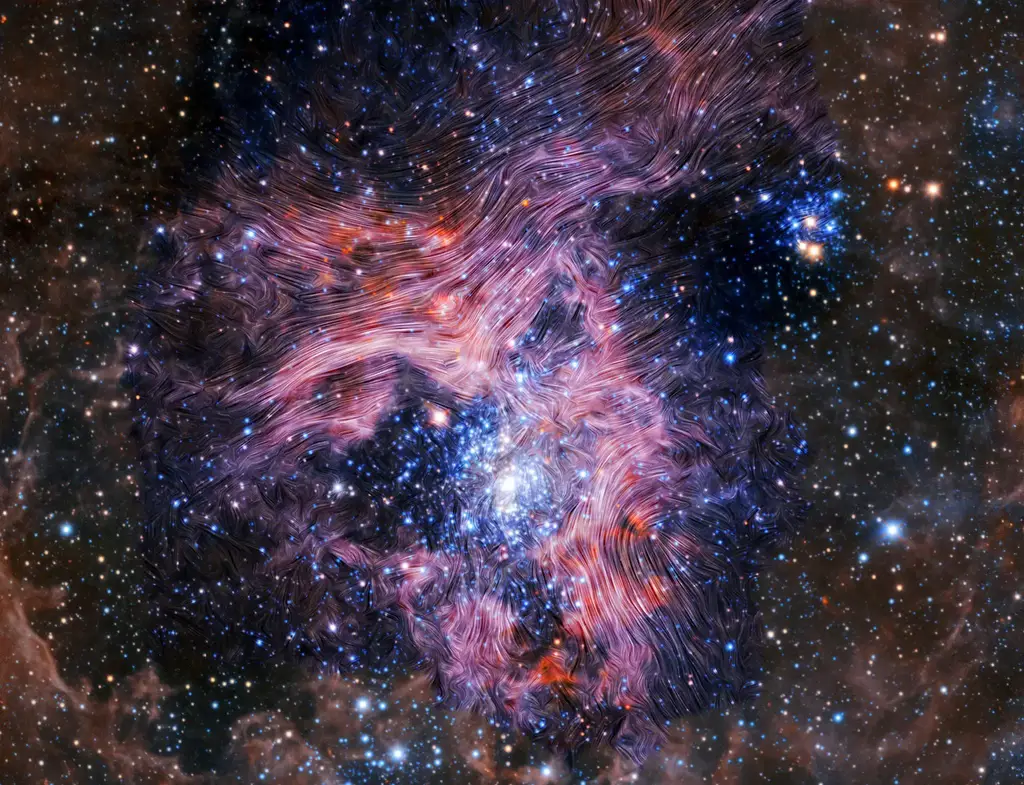30 Doradus, also known as the Tarantula Nebula, is a region in the Large Magellanic Cloud. Streamlines show the magnetic field morphology from SOFIA HAWC+ polarization maps. These are superimposed on a composite image captured by the European Southern Observatory’s Very Large Telescope and the Visible and Infrared Survey Telescope for Astronomy. Credit: Background: ESO, M.-R. Cioni/VISTA Magellanic Cloud survey. Acknowledgment: Cambridge Astronomical Survey Unit. Streamlines: NASA/SOFIA

New research from the Stratospheric Observatory for Infrared Astronomy (SOFIA) has shown that the magnetic fields in 30 Doradus — a region of ionized hydrogen at the heart of the Large Magellanic Cloud — could be the key to its surprising behavior.
Most of the energy in 30 Doradus, also called the Tarantula Nebula, comes from the massive star cluster near its center, R136, which is responsible for multiple, giant, expanding shells of matter. But in this region near the nebula’s core, within about 25 parsecs of R136, things are a bit weird. The gas pressure here is lower than it should be near R136’s intense stellar radiation, and the area’s mass is smaller than expected for the system to remain stable.
Using SOFIA’s High-resolution Air𝐛𝐨𝐫𝐧e Wideband Camera Plus (HAWC+), astronomers studied the interplay between magnetic fields and gravity in 30 Doradus. Magnetic fields, it turns out, are the region’s secret ingredient.
The recent study, published in The Astrophysical Journal, found the magnetic fields in this region are simultaneously complex and organized, with vast variations in geometry related to the large-scale expanding structures at play.
But how do these complex-but-organized fields help 30 Doradus survive?
In most of the area, the magnetic fields are incredibly strong. They’re strong enough to resist turbulence, so they can continue to regulate gas motion and hold the cloud’s structure intact. They’re also strong enough to prevent gravity from taking over and collapsing the cloud into stars.
However, the field is weaker in some spots, enabling gas to escape and inflate the giant shells. As the mass in these shells grows, stars can continue to form despite the strong magnetic fields.
Observing the region with other instruments can help astronomers better understand the role of magnetic fields in the evolution of 30 Doradus and other similar nebulae.
Reference: “SOFIA Observations of 30 Doradus. II. Magnetic Fields and Large-scale Gas Kinematics” by Le Ngoc Tram, Lars Bonne, Yue Hu, Enrique Lopez-Rodriguez, Jordan A. Guerra, Pierre Lesaffre, Antoine Gusdorf, Thiem Hoang, Min-Young Lee, Alex Lazarian, B-G Andersson, Simon Coudé, Archana Soam, William D. Vacca, Hyeseung Lee and Michael Gordon, 21 March 2023, The Astrophysical Journal.DOI: 10.3847/1538-4357/acaab0
SOFIA was a joint project of NASA and the German Space Agency at DLR. DLR provided the telescope, scheduled aircraft maintenance, and other support for the mission. NASA’s Ames Research Center in California’s Silicon Valley managed the SOFIA program, science, and mission operations in cooperation with the Universities Space Research Association (USRA), headquartered in Columbia, Maryland, and the German SOFIA Institute at the University of Stuttgart. The aircraft was maintained and operated by NASA’s Armstrong Flight Research Center Building 703, in Palmdale, California. SOFIA achieved full operational capability in 2014 and concluded its final science flight on September 29, 2022.





